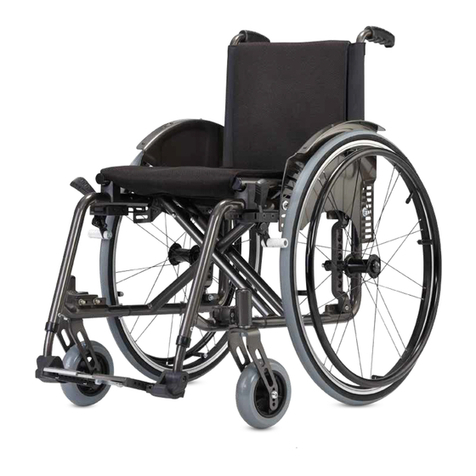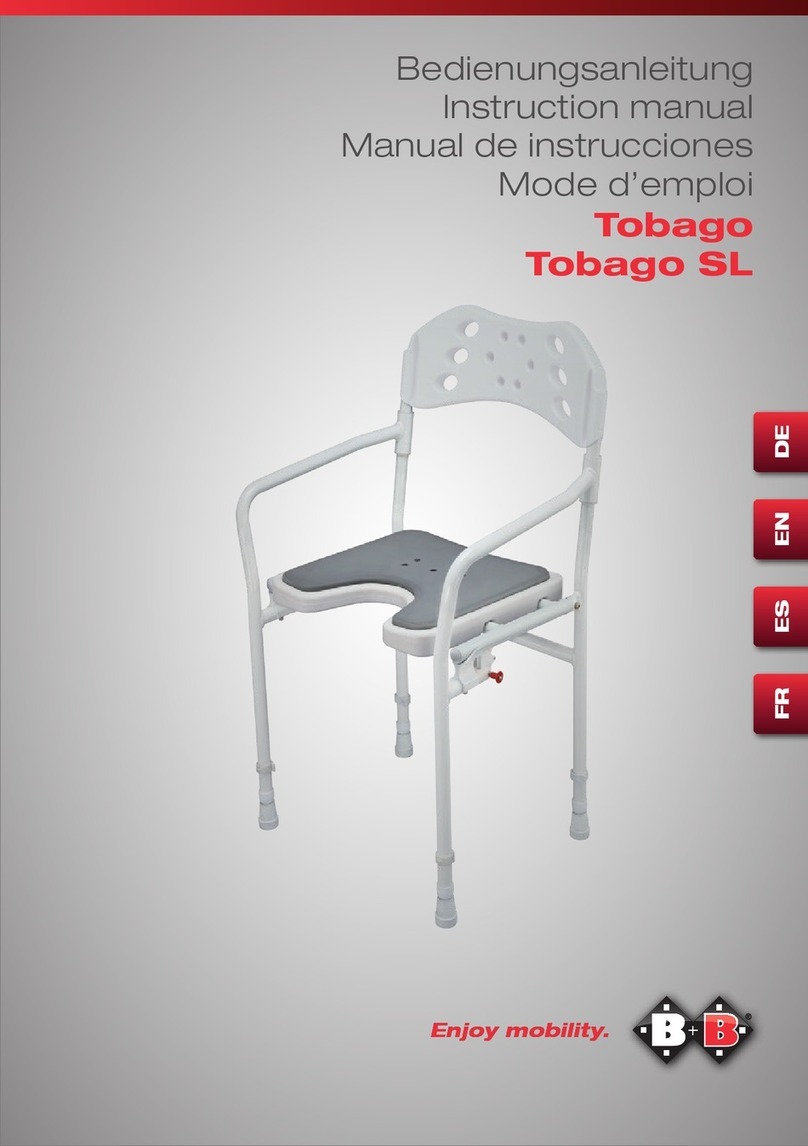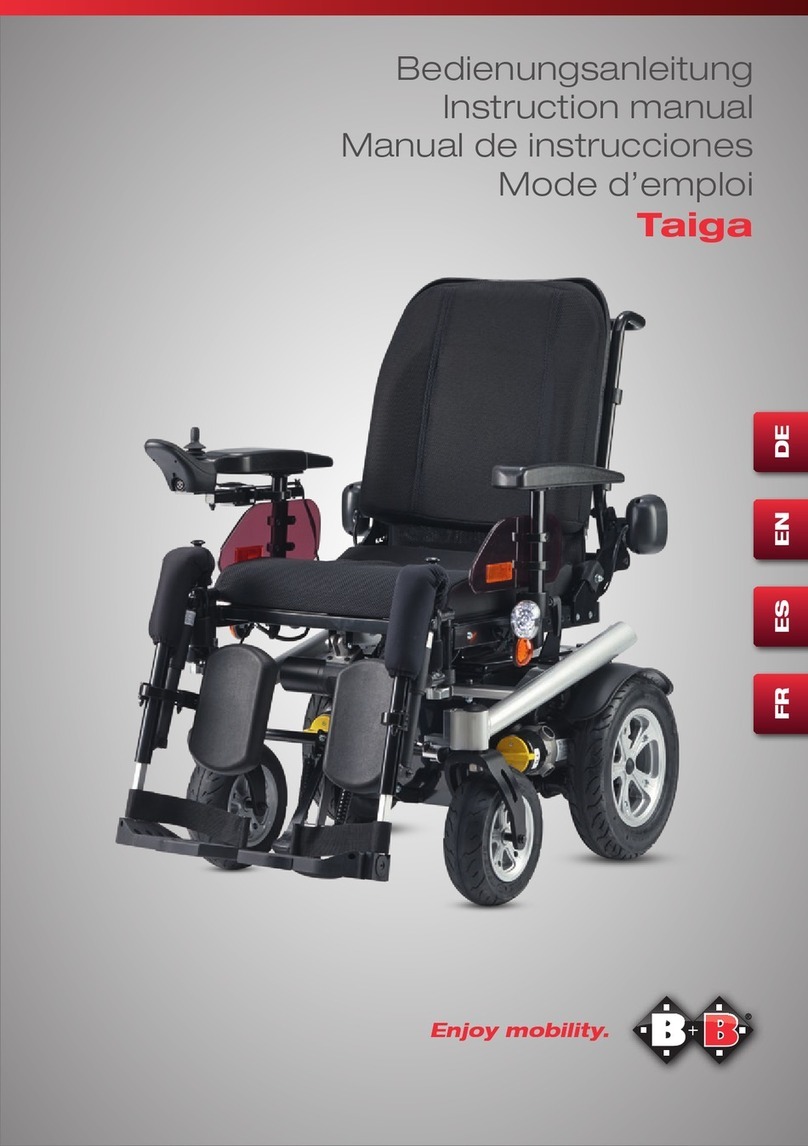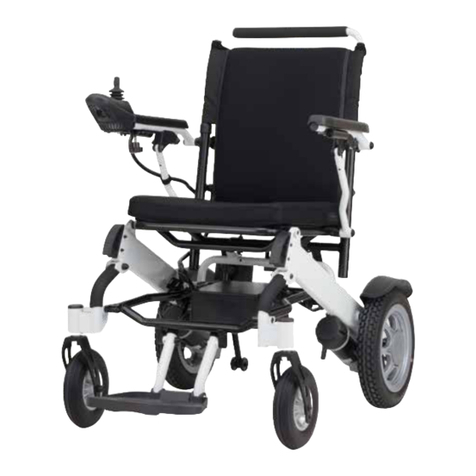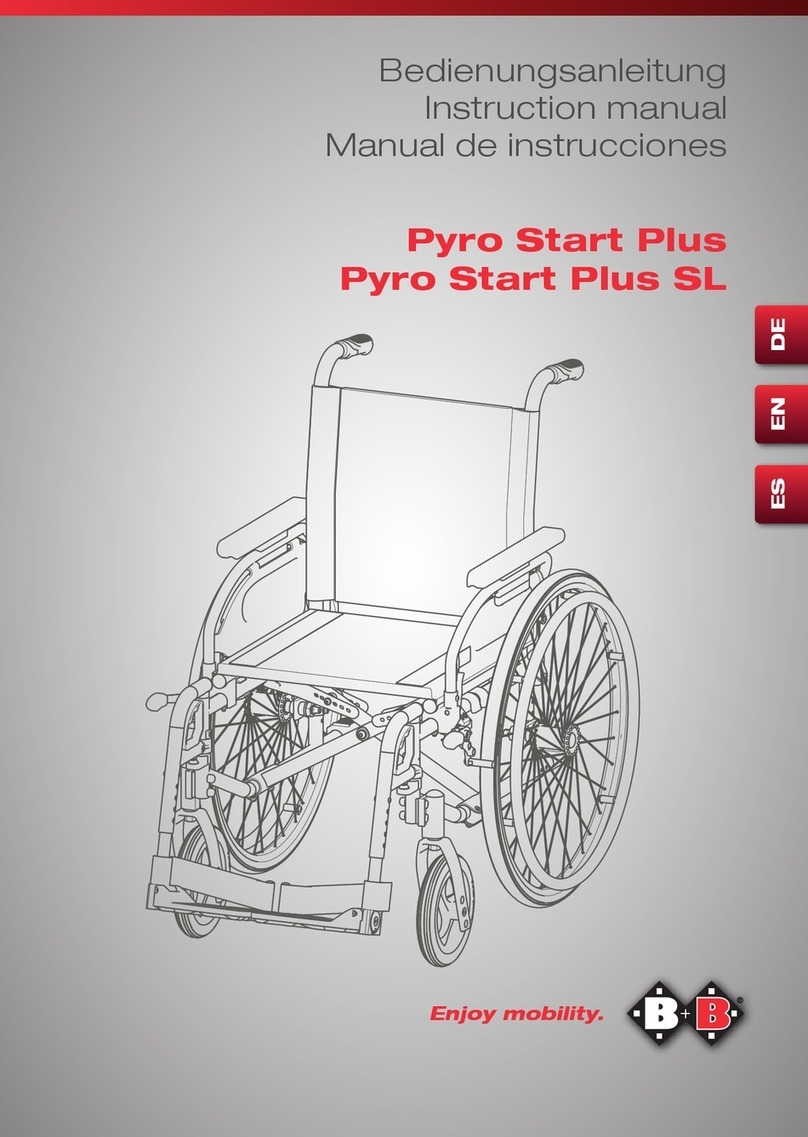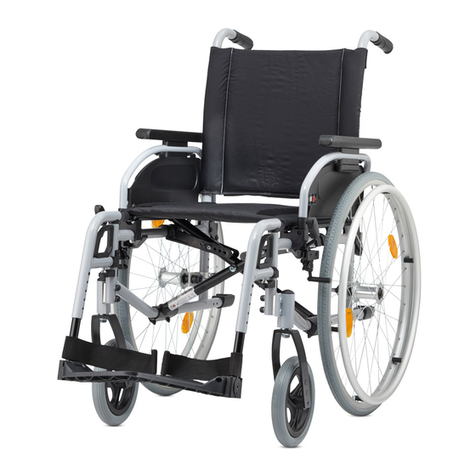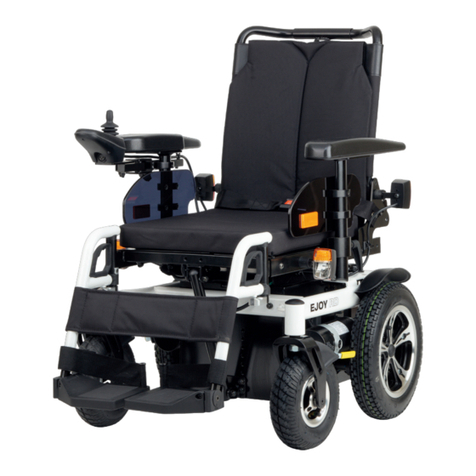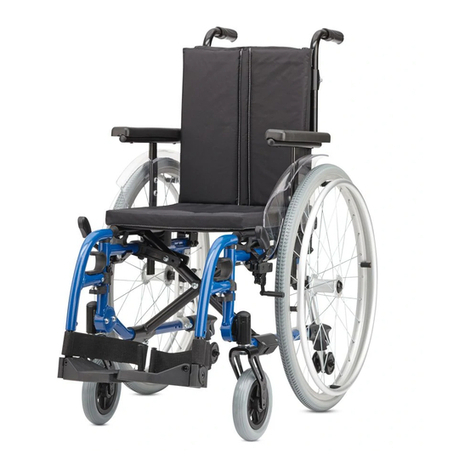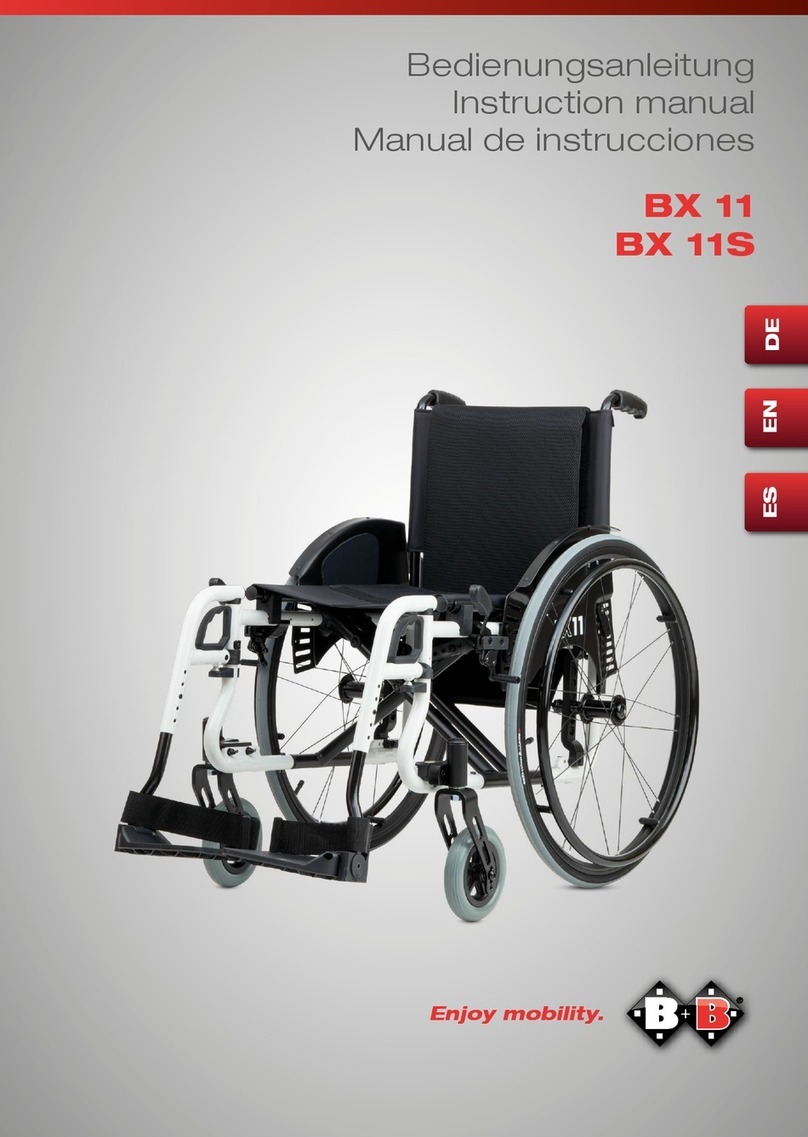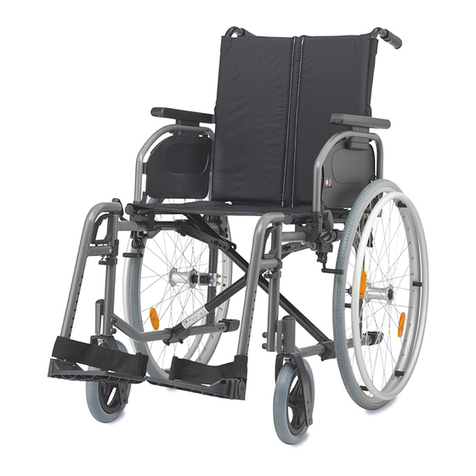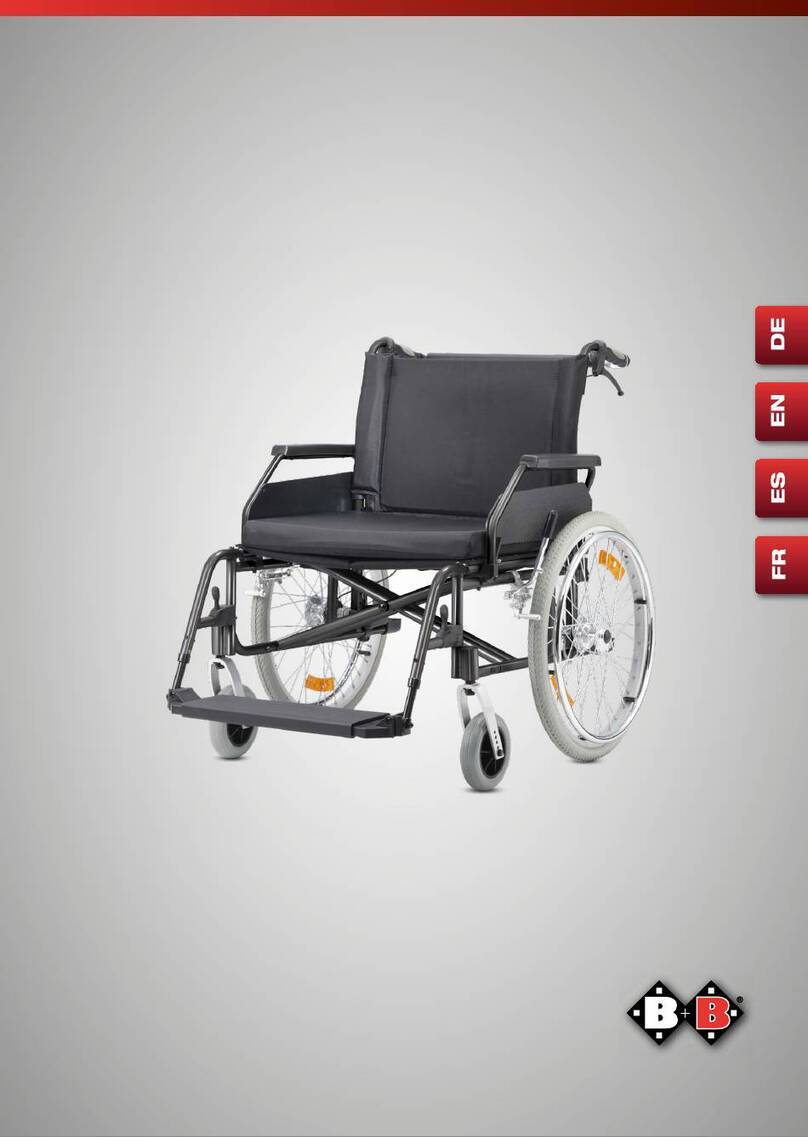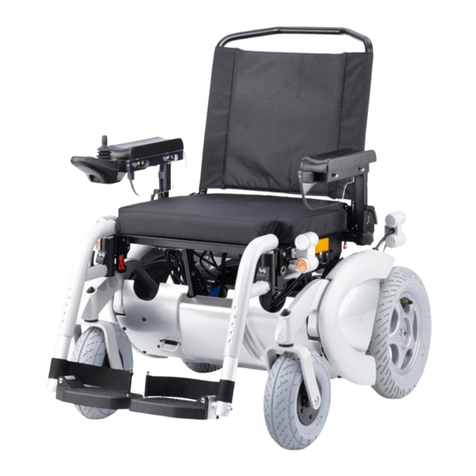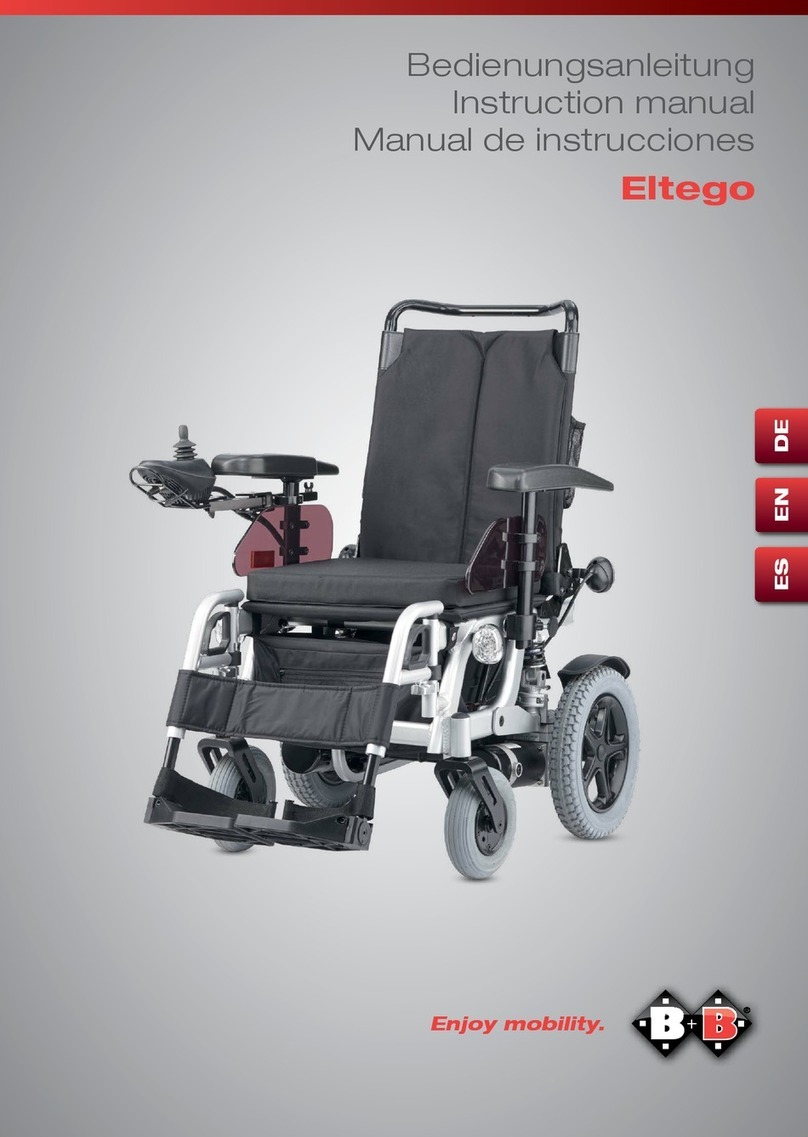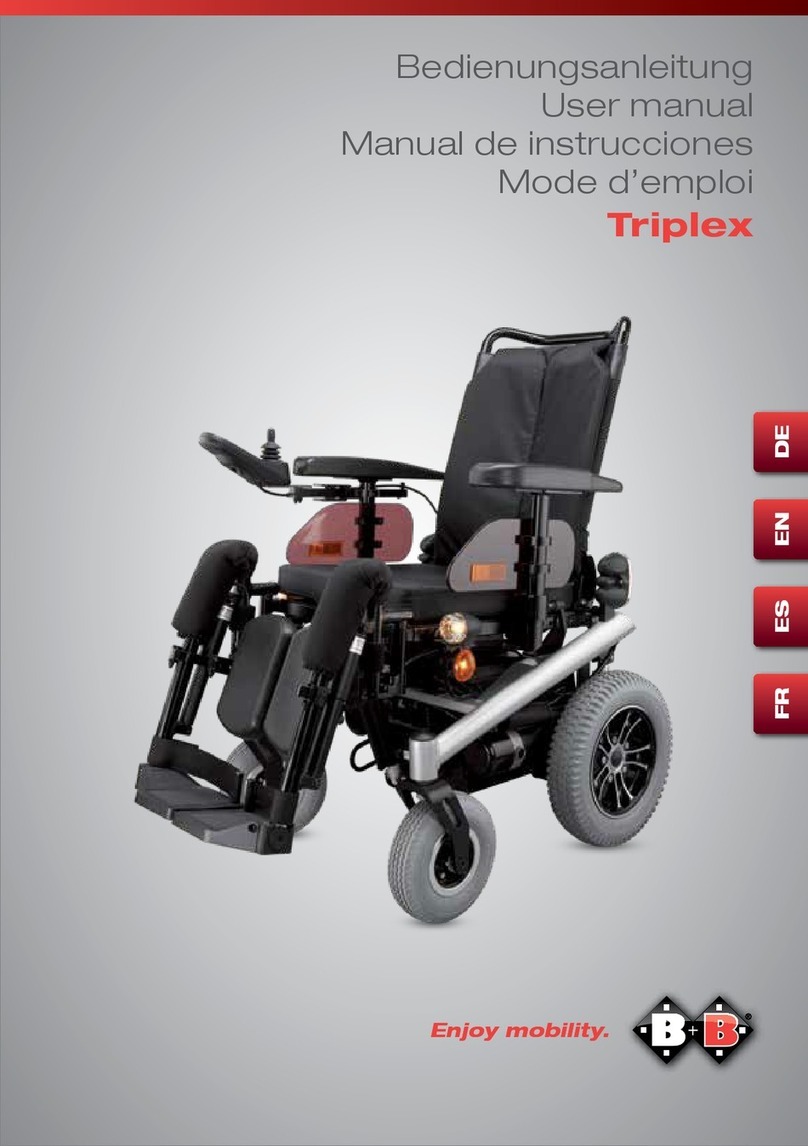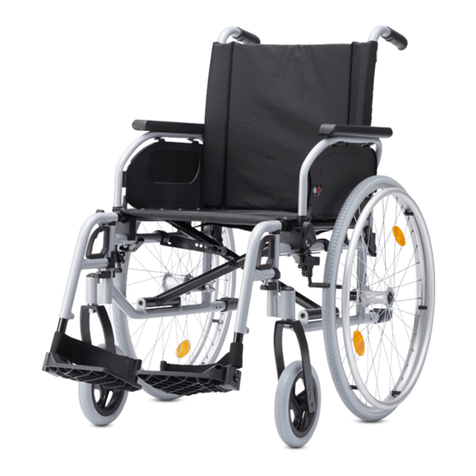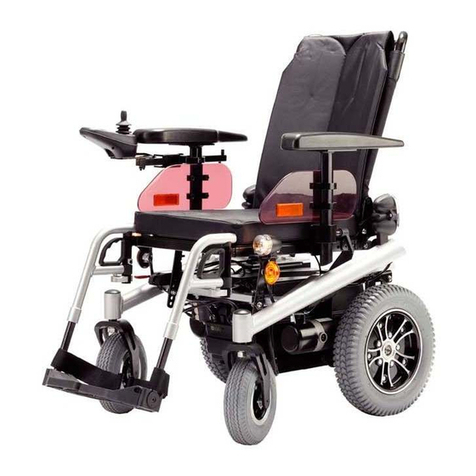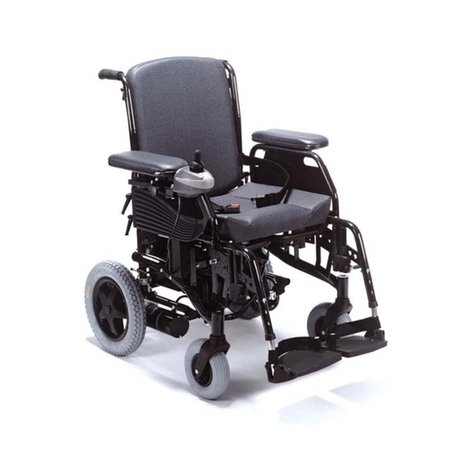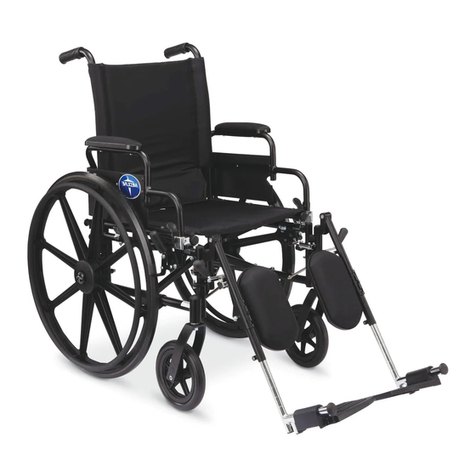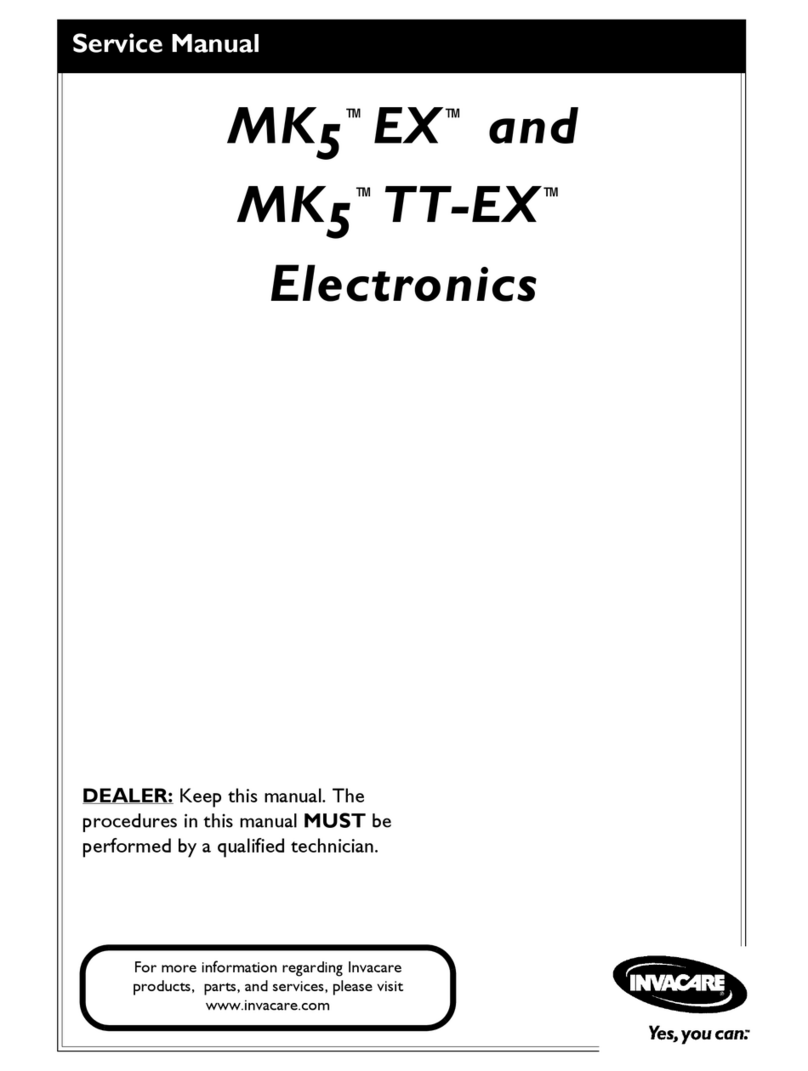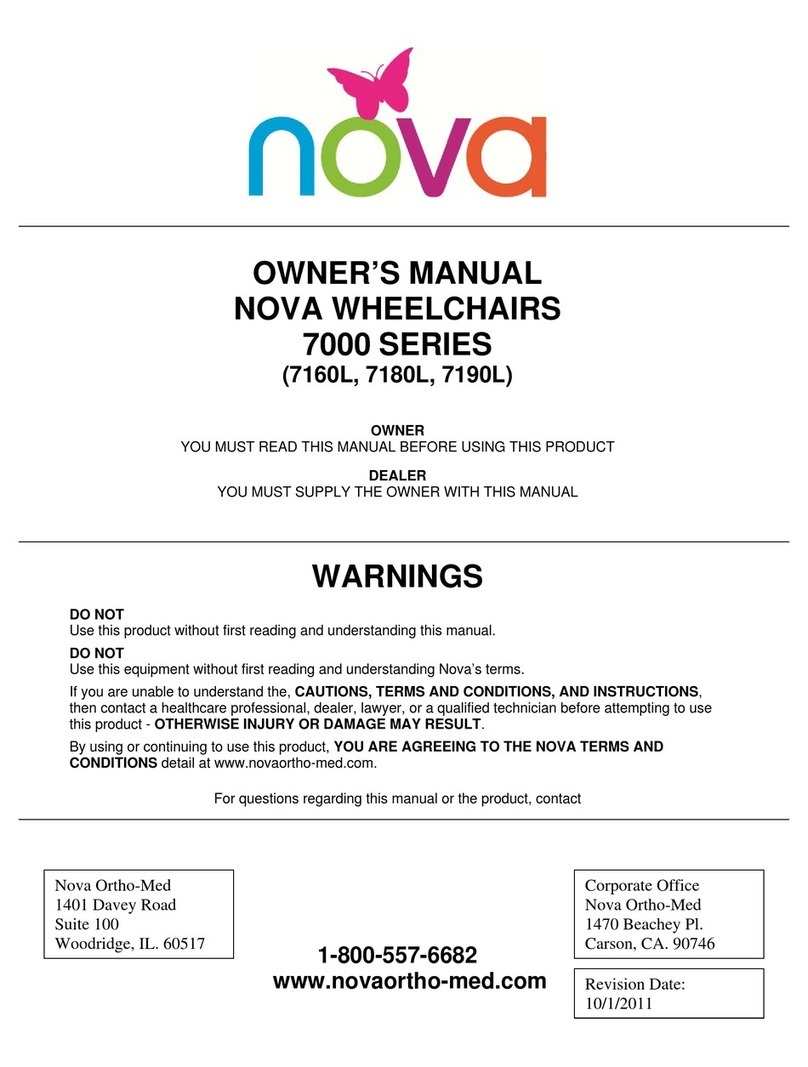B+B triplex User manual

Enjoy mobility.
Bedienungsanleitung
Enjoy mobility.
Instruction manual
Triplex

Bischoff & Bischoff GmbH | 16.06.2015
EN
32
TRIPLEX | Electric Wheelchair Electric Wheelchair | TRIPLEX
4. Using the wheelchair 16
4.1. General functions 16
4.2. Description of functions of VR-2 control 19
4.3. Description of functions of R-Net control system 20
4.4. Entering and leaving 22
4.5. Driving the wheelchair 23
4.6. Leg supports 24
4.7. Pushing the wheelchair 25
5. Technical data 26
6. Care instructions for the user 27
6.1. Cleaning and disinfection 27
6.2. Check before use 28
6.2.1. Brake check 28
6.2.2. Checking lights, indicators and horn 28
6.2.3. Checking the tyres 28
6.3. Batteries 28
6.3.1. Charging 29
6.3.2. Replacing batteries 30
7. Maintenance tips for retailers 31
8. Disposal 32
9. Transfering the wheelchair 32
10. Maintenance 32
11. Transport 33
12. Warranty 34
Inhaltsverzeichnis
1. Introduction 04
1.1. Signs and symbols 05
2. Important safety instructions 05
2.1. General safety instructions 05
2.2. Advice regarding EMC interference 07
2.3. Brakes 07
2.4. Use on public roads 07
2.5. Purpose 07
2.6. Indications for use 08
2.7. Contraindication 08
2.8. Declaration of conformity 08
3. Description of product and contents 08
3.1. Inspection on delivery 08
3.2. Type plate and serial number 09
3.3. Contents 10
3.4. Summary 10
3.5. Basic settings 11
3.5.1. Mechanical footrests 11
3.5.2 Electronic footrests 12
3.5.3. Seat 13
3.5.4. Electronic adjustment functions 14
3.5.5. Side parts 14
3.5.6. Armrests 15
3.5.7. Control unit 15
3.5.8. Seatbelt 16

Bischoff & Bischoff GmbH | 16.06.2015
EN
54
TRIPLEX | Electric Wheelchair Electric Wheelchair | TRIPLEX
1. Introduction
Dear user,
You have decided on a high-quality B+B electric wheelchair, and we
would like to thank you for your trust.
The electric wheelchair was designed to offer you many advantages
and meet your needs. The wheelchair can be fitted to your individual
body size thanks to a multitude of adjustable features and optimal
adaptability such as the length of the lower leg, the recline of the
backrest, the sag of the backrest as well as the swing away function of
the control unit and the choice of mounting the control unit either to
the left or the right side.
The Triplex can be supplied with two different control systems. The VR-2
control system offers you the possibility to adjust up to two components
electronically. The R-Net control system allows an electrical adjustment
of up to four components. These are seat angle, back angle and knee
angle (right and left). Thus, the Triplex can easily be customised to your
specific needs.
The electric wheelchair is designed for indoor and outdoor use.
The electric wheelchair is designed for indoor and outdoor use. Before
using your new electric wheelchair for the first time, please read and
follow the instructions in this manual carefully. The instruction manual
is an integral and necessary part of the wheelchair. This is why you
should keep it close by and include it when passing on the wheelchair
to someone else.
Any repairs and adjustments require special technical training and may
therefore only be carried out by authorized B+B dealers.
1.1. Signs and symbols
Warning: These are especially safety-relevant
instructions. Follow the directions in the manual!
Important: This is especially useful information on
a given subject.
2. Important safety instructions
2.1. General safety instructions
• To avoid falls and dangerous situations, you should first practice
driving your new wheelchair on level, unobstructed ground. We
recommend having an assistant with you.
• Please make sure that all parts have been properly installed before
using the wheelchair.
• Practice driving on level, unobstructed ground before first use.
Get a good understanding for the way the wheelchair brakes and
accelerates when driving straight ahead or a curve.
• Please note that displacing the center of gravity by shifting the
body or by adding loads may increase the risk of tipping over the
wheelchair to the side or backwards.
• The wheelchair may not be used for transport of more than one
person or any additioonal load. Make sure to only use it for the
intended purpose.
• Beware of the risk of trapping body parts when setting and
adjusting the wheelchair.
• Never use the wheelchair under the influence of alcohol or other
substances that may impair your attention and/or your physical
and mental capacity.

Bischoff & Bischoff GmbH | 16.06.2015
EN
76
TRIPLEX | Electric Wheelchair Electric Wheelchair | TRIPLEX
• To overcome obstacles, please be sure to use ramps. Should it
be necessary to lift the Triplex over an obstacle, then only do so
without the occupant. Only lift by the solid parts of the frame.
• Avoid hitting obstacles (steps, curbs) at full speed.
• Please pay attention to the tilt prevention feature on steps, lifting
platforms and ramps. Make sure there is enough clearance on top,
on the bottom and on the sides.
• The control unit must always be switched off when getting in or
out of the wheelchair.
• All road traffic regulations must be observed when driving on
public roads.
• The rear lights at the wheelchair must always be visible to other
road users.
• If possible, wear bright, conspicuous clothing. This will make it
easier for other road users to see you.
• Please note that the upholstery will heat up if directly exposed to
sunlight and may cause injuries to your skin when touched. You
should therefore cover these parts or protect the wheelchair from
exposure to direct sunlight.
• Please note the increased risk to the user, passenger and third
parties of getting trapped when using the electric seat adjustment.
Please note that operating the wheelchair in
push mode by uncoupling the drive mechanism
will deactivate the electro-magnetic brakes. The
wheelchair should therefore only be used on level
ground in this mode. Non-observance may lead to
life-threatening situations.
2.2. Advice regarding EMC
interference
Despite meeting all applicable EMC guidelines and standards it is
possible that the wheelchair will experience interference from other
electrical devices (e. g. cell phones) or interfere with these. Should you
notice such interference, either turn off the other device or your electric
wheelchair and move it outside the interference range.
2.3. Brakes
The wheelchair is brought to a standstill by the automatic brake after
releasing the joystick. When the wheelchair is being pushed no parking
brake is available when the drive mechanism is disconnected. To lock
the wheelchair in place, you need to reconnect the drive mechanism.
Stop the wheelchair first. In an emergency, it can also be engaged
whilst in motion e.g. on steep paths.
2.4. Use on public roads
The wheelchair is designed for indoor and outdoor use. Please keep in
mind that you are using public roads and therefore have to observe
all road traffic regulations. Do not endanger other road users through
inconsiderate driving, especially on walkways.
2.5. Purpose
The Triplex electric wheelchair is designed for indoor and outdoor use
by persons with impaired mobility.
It is therefore sufficiently compact and agile for indoor use and also
capable of handling medium distances and overcoming small obstacles
outdoors. It is classified under category B according to the EN 12184
standard. The maximum load capacity is 120 kg.

Bischoff & Bischoff GmbH | 16.06.2015
EN
98
TRIPLEX | Electric Wheelchair Electric Wheelchair | TRIPLEX
2.6. Indications for use
Inability or severely impaired ability to walk due to
• paralysis
• loss of limb
• defect/deformity of limb
• joint contracture
• joint damage (not in both arms)
• other diseases
The provision of an electric wheelchair is indicated if the use of a
handdriven wheelchair is no longer possible but the proper operation
of an
electric drive is possible.
2.7. Contraindication
The provision of an electric wheelchair is unsuitable for persons
• with severe balance disorders
• with impaired or insufficient vision
• with strongly impaired cognitive abilities
2.8. Declaration of conformity
B+B, as manufacturer and solely responsible party, hereby declares that
the electric wheelchair Triplex complies with the requirements of the EC
Directive 93/42.
3. Description of product and
contents
3.1. Inspection on delivery
All B+B products undergo a proper final inspection in our company and
are labeled with the CE mark. The wheelchair is supplied in a special
box. After unpacking save the box if possible. You may need it later for
storage or to return the product.
Assembly, adjustment to your body size and first instructions are taken
care of by your qualified medical supply dealer.
If the wheelchair is shipped by rail or road, the goods should be
checked immediately for transport damages (carton) in the presence of
the bearer. Should there be any damage, please contact our customer
service (Tel.: +49 700 6000 7070) immediately.
Check the contents for completeness and make sure nothing is
damaged. Should you find any irregularities or damage, please contact
our customer service (Tel.: +49 700 6000 7070).
3.2. Type plate and serial number
The type plate and serial number are located under the seat.
Bischoff & Bischoff GmbH
Becker-Göring-Straße 13
D - 76307 Karlsbad
Telefon 0700 - 60007070
GB
CE Sticker & EAN Codes (Size 80 mm x 23 mm)
Power Wheelchairs (crash tested)
EAN 13 SN
Model: Triplex Model no.: 8355
2015-04 Class: B (Outdoor | Indoor)
Max. weight capacity: 120kg Max. speed: 6 km/h
Manufacturer logo
Manufacturer
information
RoHS logo
CE mark
Not suitable for use as a
seat in a vehicle
Important - Adhere to the
operating instructions
Model designation
Model number
Application class
Date of manufacture
Maximum load capacity
Maximum speed
Serial number
A
B
C
D
E
F
G
H
I
J
K
L
M
A B C D
E F
G H I
J K L
M

Bischoff & Bischoff GmbH | 16.06.2015
EN
1110
TRIPLEX | Electric Wheelchair Electric Wheelchair | TRIPLEX
3.3. Contents
After receipt of the goods, please check the contents for completeness
right away. The contents consist of:
• outer package
• electric wheelchair (ready for use incl. 2 batteries)
• VR2 control system (R-Net with electrical adjustable components)
• charging unit
• seat cushion
• set of tools
• instruction manual
3.4. Summary
push handles
backrest
control unit
arm rest
side part
seat cushion
lights
Indicator light
drive wheel
foot rest
steering wheel
01
3.5. Basic settings
It is necessary to adjust the wheelchair to your body size before first
use. This is the only way to ensure a physiologically correct posture
allowing for long drives without tiring. Below you find a description
of the basic settings of the wheelchair. You should carry out these
adjustments with the help of your medical supply dealer.
3.5.1. Mechanical footrests
Length of lower leg supports
• The lower leg supports can be adjusted from 47 to 55 cm.
• To do so, loosen the two allen screws.
• Adjust to the desired height.
• Tighten the screws again. Use medium-strength Loctite to lock
screws in place.
Make sure to always use two screws for secure
fastening!
Angle of footrest
• The angle of the footrests is adjustable in 25° steps.
• Loosen the screwing at the side of the footrest.
• Adjust to the desired angle.
• Tighten the screw again. Use Loctite 243 to lock screw in place.
Make sure to set the angle only within the marked
range!
02
03

Bischoff & Bischoff GmbH | 16.06.2015
EN
1312
TRIPLEX | Electric Wheelchair Electric Wheelchair | TRIPLEX
3.5.2 Electronic footrests
Length of lower leg supports
• The lower leg supports can be adjusted from 47 to 55 cm.
• To do so, loosen the two allen screws.
• Adjust to the desired height (fig. 04).
• Tighten the screws again.
• Use medium-strength Loctite to lock screws in place.
Angle of footrest
• The angle of the footplate is fully adjustable.
• Undo the screw to the side of the footplate.
• Adjust the footplate to the desired angle (fig. 05).
• Tighten the screw again.
• Use medium-strength Loctite for fixation.
Make sure there is an appropriate distance between
footrests and the ground.
Height of the calf pad
• The height of the calf pad is adjustable.
• Undo the screw to the side of the footrest.
• Adjust the calf pad to the desired height (fig. 06).
• Use medium-strength Loctite for fixation.
04
05
06
3.5.3. Seat
Seat depth
• The default setting of the seat depth is 45 cm.
• You can reduce the seat depth to 40 cm. You should then use a
newly fitted seat cushion.
• To adjust the seat depth, undo the fastenings of the backrest, slide
it forward and tighten the screws again (fig. 07).
Seat angle - mechanical
This description only applies, if you have a configuration with a
mechanically adjustable seat angle.
• The default setting of the seat angle is 1° backwards.
• The seat angle can be adjusted backward in five settings.
• To do this, undo the fastening screw on the telescopic section at
the front under the seat.
• Remove the screws and adjust the seat to the desired angle (fig.
08).
• Place the screws into the nearest possible hole and tighten them
again.
Angle of the back - mechanical
This description only applies, if you have a configuration with a
mechanically adjustable back angle.
• The angle of the backrest of your electrical wheelchair can be
easily adjusted. In addition, you also have the option of entirely
folding down the backrest forwards.
• To fold down the backrest, remove the fastening pin on the
backrest and then fold down the backrest. (fig. 09)
• The angle of the backrest can be adjusted to four settings.
• Undo the fastening screw on the telescopic section at the back
under the seat.
07
08
09

Bischoff & Bischoff GmbH | 16.06.2015
EN
1514
TRIPLEX | Electric Wheelchair Electric Wheelchair | TRIPLEX
• Remove the screw and adjust the seat to the desired angle.
• Place the screws into the nearest hole and tighten them again.
Make sure that both pins, on the right and left, are
fully engaged.
3.5.4. Electronic adjustment
functions
Depending on the configuration it may also be possible to adjust the
angle of the seat, backrest and footrests electronically. For further
details, see chapter 4, “Using the wheelchair”.
Beware of the risk of to the user, carer and third
parties when electronically adjusting the seat
functions.
3.5.5. Side parts
You can slide the side parts sideways.
• Undo the fastening screw underneath the seat and slide the side
part into the desired position (fig. 10).
• Tighten the screw again.
Make sure the fastening is firmly tightened.
10
3.5.6. Armrests
The armrests can be completely taken off to be able to get in and out
of the chair from the side. In addition, the height of the armrests can
be adjusted. They can also be adjusted sideways by adjusting the side
parts (see side parts).
Removing the armrests
• To remove the armrest, loosen the wing bolt and pull out the
armrest to the top (fig. 11).
• When installing the armrest, make sure it is inserted all the way
and fastened again.
Adjusting the height
• First take the armrest out of the mounting.
• Remove the arresting bolt and screw it back into the armrest at the
desired position (fig. 12).
• The lowest hole represents the maximum height of the armrest.
3.5.7. Control unit
• The control unit can be mounted either on the right or left-hand
side underneath the armrest each.
• The control unit must be adjusted by a qualified mobility dealer to
warrant safe functionality of the wheelchair.
Adjusting the height
• The distance to the armrest can be adjusted.
• Loosen the screw connection on the inner side of the side part.
(fig. 13)
• Move the control unit into the desired position, then tighten the
screw again.
11
12
13

Bischoff & Bischoff GmbH | 16.06.2015
EN
1716
TRIPLEX | Electric Wheelchair Electric Wheelchair | TRIPLEX
Distance from the armrest
• You can adjust the position of the control unit to your forearm
length.
• Loosen the hand screw on the outer side of the side part.
• Move the control unit into the desired position, then tighten the
screw again (fig. 14).
Don’t forget that the cables to the control unit
have to be repositioned. This should be done by an
expert.
3.5.8. Seatbelt
The seatbelt is attached to the side of the backrest.
• Adjust the length of the seatbelt by positioning the buckle
accordingly (fig. 15).
• Fasten the seatbelt with the latch.
• Open the seatbelt by pushing the red button at the latch.
4. Using the wheelchair
After adjusting the wheelchair to your personal needs, familiarize
yourself with the control functions.
4.1. General functions
Light
Use this button to switch on the active lighting system of your
wheelchair when darkness falls or when travelling through
dark areas such as tunnels. This will make you more visible to
other traffic (fig. 16).
14
15
16
Warning indicators
Press this button to switch on the warning indicators in emergency
situations, such as inability to move the wheelchair. All four indicator
lights will flash and signal other traffic that your wheelchair is disabled
(fig. 17).
Indicators (left/right)
Use this button (fig. 18) to switch on the left or right indicators of
your wheelchair to signal other traffic that you wish to change your
direction of travel to the left or right. Press the button again to switch
off the indicators.
Battery status display
The battery status display (fig. 19) shows the charge status. If the
display is in the green range, the battery is sufficiently charged. If the
display is in the red range, the wheelchair can only be used for a short
distance and the battery should be charged as soon as possible (see
charging procedure).
ON/OFF button
Press this button to switch on the wheelchair (fig. 20).
17
18
19
20

Bischoff & Bischoff GmbH | 16.06.2015
EN
1918
TRIPLEX | Electric Wheelchair Electric Wheelchair | TRIPLEX
Display of mode
The mode display shows the preselected mode. Settings from 1 to 5
LEDs are available. The modes indirectly define the maximum available
speed when the joystick is moved, i.e. in mode 5 the highest maximum
speed is available and in mode 1 the lowest (fig. 21).
Setting the mode
Press these buttons to change the mode, i.e. increase (right) or reduce
(left) the maximum available speed. The speed is controlled by
movement of the joystick (fig. 22).
Horn
Press this button to sound the horn (fig. 23).
Immobiliser
To protect your wheelchair from unauthorised use or theft store it in a
locked room or activate the immobiliser.
• Press and hold the On/Off button until you hear a beep and
release it.
• Move the joystick in the direction of travel and then to the neutral
position. It will beep in each position. Now the control is locked.
• Switch on the controller with the On/Off button.
• Move the joystick in the direction of travel and then to the neutral
position. It will beep in each position. Now the control is released.
21
22
23
4.2. Description of functions of
VR-2 control
24
25

Bischoff & Bischoff GmbH | 16.06.2015
EN
2120
TRIPLEX | Electric Wheelchair Electric Wheelchair | TRIPLEX
Adjustment functions
Use this button (fig. 26) to activate the electronic adjustment functions.
Move the joystick to the left or right to choose between the two
possible adjustment functions. These are indicated by the two LEDs
below the button. The functions are adjusted by moving the joystick
up and down.
4.3. Description of functions of
R-Net control system
27
28
26
Display panel of the adjustment functions
Illuminated LEDs of the respective adjustment function (left footrest,
right footrest, seat, back) indicate which adjustment function is
currently active.
29
Adjustment functions
Use this button (fig. 30) to activate the electronic adjustment
functions. Move the joystick to the left or right to choose between the
four possible adjustment functions. These are indicated by LEDs on the
display panel. The functions are adjusted by moving the joystick up or
down.
30

Bischoff & Bischoff GmbH | 16.06.2015
EN
2322
TRIPLEX | Electric Wheelchair Electric Wheelchair | TRIPLEX
4.4. Entering and leaving
Entering and leaving from the side
• Move the wheelchair as close as possible to the present or future
seat so they are side by side.
• If you wish to move from another wheelchair or room chair, lock it
by setting the parking brakes.
• Lock the Triplex to prevent it from moving accidentally by pressing
the On/Off button to switch off the control (all displays off).
• Remove the arm rest and side section.
• Fold the foot plates to the side or remove the leg rests.
• Now slide sideways onto the other seat.
• Make sure that you are sitting as far back in the seat as possible.
• Move the arm rest and leg rests to the original position.
Entering and leaving from the front
• First fold the foot plates up or remove the leg rests.
• Move the Triplex as close as possible to the present or future seat
front to front.
• If you wish to move from another wheelchair or room chair, lock it
by setting the parking brakes.
• Now slide onto the seat by turning your body around.
• Then move the arm rest and leg rests to the original position.
4.5. Driving the wheelchair
Before moving check that the solenoid brake is
correctly locked.
Commissioning
• Sit in the seat of your B+B wheelchair and place your legs of the
footrests.
• Make sure that you are sitting as far back in the seat as possible.
• Make sure that there is no loose clothing such as scarves, shirts etc.
is hanging from the wheelchair and could be caught in the wheels.
• Make sure that you are comfortably and securely seated.
• Press the On/Off button to switch on the Triplex.
• All electrical driving functions are now available.
Driving functions
• Your dealer can adjust the values for speed, acceleration and
deceleration to your requirements subject to the legal regulations.
• For a start select a low mode and increase it while moving if
required.
• Use the joystick to start moving.
• The joystick is used simultaneously to increase the speed and to
change the direction of movement.
• When the joystick is in the central position, the wheelchair
is mechanically braked and locked to prevent it from moving
unexpectedly.

Bischoff & Bischoff GmbH | 16.06.2015
EN
2524
TRIPLEX | Electric Wheelchair Electric Wheelchair | TRIPLEX
Moving forward: to move forward in a straight line move the joystick
cautiously forward. The further forward the joystick is moved, the faster
your wheelchair gets. If you release the joystick the wheelchair will
automatically be braked to a stop.
Reversing: to move in reverse mode, move the joystick cautiously
back. The further back the joystick is moved, the faster your wheelchair
gets. If you release the joystick the wheelchair will automatically be
braked to a stop.
Turning corners:To change direction of travel, tilt the joystick to the
left or right. This can also be done when the joystick is tilted forwards
or backwards, i.e. while driving backwards or forwards.
4.6. Leg supports
Mechanical leg-rests
To make it as easy as possible to enter and leave your wheelchair, the
foot plates can be folded up, or the leg rests can be swung to the side
out of the way or removed.
• Open the lock to swing the leg rest to the side (fig. 31).
• The leg rest in the swung-out position can be completely removed
(fig. 32).
• When you want to replace the leg rest, proceed in reverse order.
• Move the leg rest to the forward position until you hear it lock into
place.
Electronic leg-rests
In order to make getting in and out as easy as possible, you can fold
the foot-plates upwards and pivot the calf rests outwards. You can also
swing out or raise the footrests.
• First remove the connection cable to the foot rests.
• To pivot the footrest outwards, open the locking device (fig. 33).
• In the “external position” the footrest can be removed entirely.
• To reassemble the footrest reverse the process.
31
32
• Swing the footrest forwards until you hear it click into place.
4.7. Pushing the wheelchair
If you wish to push the wheelchair in some situations, the brakes must
be unlocked. The wheelchair is easy to push in freewheel mode.
Caution! The electromechanical brake is disabled in
this mode.
• Move the unlocking levers down.
• A small jerk will indicate that the drives are now unlocked.
• To lock them again pull the unlocking levers up and they will lock
automatically.
For safety reasons the motor drive is locked in
freewheel mode.
Caution! Danger of fatal injury! The drives must
only be unlocked on level ground.
33
34

Bischoff & Bischoff GmbH | 16.06.2015
EN
2726
TRIPLEX | Electric Wheelchair Electric Wheelchair | TRIPLEX
5. Technical data
Dimensions and weigths
Max. load capacity: 120 kg
Seat width: 45 cm
Seat height: 54 cm
Seat depth: 40 bis 45 cm
Seat angle: -2° bis +10°
+2° bis +20° (electrical adjustment)
Seat back height: 55 cm
Seat back angle: 90°, 100°, 110°, 120°
90° bis 135° (electrical adjustment)
Overall length: 106 cm with supports
Overall width: 60,5 cm
Unloaded weight: 88,3 kg incl. batteries
Tyres
Drive wheels: 3.00-8 mm (PU)
Swivelling wheels: 2,80/2,50-4 mm (PU)
Elektrical system
Main fuse: 50 A
Battery: 2 x 12V / 50 Ah (Gel)
Batterry charger: 24VDC / 4A (HP8204B)
Motor: DC 24 V /9MA-450L, 450 W
Controller: PG Drives VR2-L, R-Net LED-L
Lights and indicators: as required by German traffic regulations
Driving characteristics
Speed: 6 km/h
Climbing capacity: 8°
Obstacle heigth: 50 mm (Driving forwards)
Range: 32 km
Turning circle: 120 cm
Equipment
Frame: powder-coated steel frame
Brake: automatic braking system conforms to the
German Road Traffic Licensing Regulations
(StVZO)
Operating forces
Joystick: approx. 1 N
Buttons on the control
panel: approx. 1 N
Disconnecting the drive
mechanisms: > 60 N
6. Care instructions for the user
6.1. Cleaning and disinfection
Make sure that the wheelchair is switched off before starting to clean
it.
• The frame sections and panels of the wheelchair can be wiped
with a damp cloth. A mild cleaning agent can be used for stubborn
dirt.
• The wheels can be cleaned with a damp brush with plastic bristles
(do not use a wire brush).
• The seat, seat back and arm rests can be cleaned of dust and
minor dirt with a damp cloth. Do not use aggressive cleaning
agents, because they may attack the surface of the material. The
cushions can be washed with warm water at 40°C and disinfected
with a standard disinfectant.
• Please note that electrical and electronic components must not
come into contact with water unnecessarily.
Caution! Do not use high pressure cleaners or
steam cleaners.

Bischoff & Bischoff GmbH | 16.06.2015
EN
2928
TRIPLEX | Electric Wheelchair Electric Wheelchair | TRIPLEX
6.2. Check before use
6.2.1. Brake check
Every time you use the wheelchair check the brake system. Move forward
slowly and release the joystick. The wheelchair must come to a stop in
the normal manner. When it is at a standstill the mechanical brake
must lock with an audible click. If you detect unusual brake behaviour,
inform your dealer immediately and do not use the wheelchair. The
motor brake operates correctly if you cannot push the wheelchair when
it is switched off. However, if it can be moved, the electromagnetic
brake is faulty. Do not use the wheelchair if this is the case. Contact
your dealer immediately.
6.2.2. Checking lights, indicators
and horn
Before moving off in the wheelchair always check the operation of
the lighting system, the indicators and horn. If you press the button
and there is no response from the equipment, inform your dealer
immediately and do not use the wheelchair.
6.2.3. Checking the tyres
Before moving off in the wheelchair always check that the tyres are
undamaged and the tyre pressure is adequate. If the pressure is too
low, the tyres must be pumped up. Check the tyre tread depth at least
once a month. It should be at least 1 mm. Defective or worn tyres must
be replaced by the dealer.
6.3. Batteries
The wheelchair is equipped with maintenance-free gel batteries
whose fluid level does not need to be checked. If you do not use your
wheelchair for an extended period, the batteries should be charged
every two months, otherwise they may be destroyed by deep discharge.
Make a habit of checking the battery status display on the control
every time before using your wheelchair. If the battery status display
shows only the red LEDs, do not travel long distances and connect the
battery charger to the wheelchair
as soon as possible (VR2 control). We recommend charging the battery
after every time the wheelchair is used.
6.3.1. Charging
Charging for the first time:
To charge the batteries to their maximum capacity proceed as follows:
• Discharge the factory-charged batteries until the LED display
shows two bars.
• Charge the batteries as described below (approx. 16 hours).
• Discharge the batteries again to two bars on the LED indicator.
• Finally charge the batteries as described.
Use only approved battery chargers to charge
the batteries (see Technical Data). Follow the
instructions for use of the battery charger.

Bischoff & Bischoff GmbH | 16.06.2015
EN
3130
TRIPLEX | Electric Wheelchair Electric Wheelchair | TRIPLEX
Before using the battery charger check that the mains connection is
230 V.
• Switch off the wheelchair first.
• Connect the battery charger to the wheelchair. The charging jack is
on the side under the control.
• Plug the mains plug of the battery charger into the mains socket
(230 V).
• The charge indicator (green) of the battery charger shows the
status of the charging process.
Red – battery charger is switched on
Yellow – charging
Green : charging is complete
• Once charging is complete, disconnect the mains plug and
disconnect the battery charger from the wheelchair.
6.3.2. Replacing batteries
When working on the batteries be very careful, do not use metal tools,
do not touch the battery terminals and follow the directions of the
battery manufacturer.
Caution! This work should only be done by a trained
technician. Danger of electrocution!
Use only batteries approved for this wheelchair (see technical data).
Make sure that the wheelchair is switched off before starting to replace
batteries.
35
36
• First remove the battery cover.
• Loosen the screws on the right and left.
• Now the belts that hold the battery can be released.
• Disconnect the battery cable. First the red terminal and then the
black terminal. Make sure you use insulated tools and do not
contact metal frame parts while disconnecting the cables.
• Lift the batteries carefully out by the handles.
• Install the new batteries in their correct position and connect the
terminals. Note the correct colour-coding (red and black).
• Secure the batteries with the belts and attach the battery cover.
When the batteries have reached the end of their
life, i.e. they can no longer be adequately charged,
they must not be disposed of with household
rubbish. Old batteries are returned to the dealer
when new batteries are purchased and correctly
disposed of.
7. Maintenance tips for retailers
We recommend having the complete wheelchair inspected by the
dealer at least once a year. If faults or defects in the wheelchair are
found, it must be returned to the dealer for repair immediately. The
dealer can receive the required information, documentation and circuit
diagrams for repair and service on request. A training program is also
available for dealers.
B+B customer service is available to answer questions at
+49 (0)700/60007070.
37
38

Bischoff & Bischoff GmbH | 16.06.2015
EN
3332
TRIPLEX | Electric Wheelchair Electric Wheelchair | TRIPLEX
8. Disposal
If the wheelchair is no longer used and you wish to dispose of it, please
contact your dealer.
If you wish to dispose of it yourself, please
contact a local recycling company for the disposal
regulations of your jurisdiction.
9. Transfering the wheelchair
When the wheelchair is transferred to a new owner, please include all
the technical documentation with it for the new user.
The wheelchair must be inspected in accordance
with the service schedule and must be in good
condition.
10. Maintenance
Our customer service can provide a service schedule for the wheelchair.
11. Transport
You can determine whether or not your wheelchair is approved for use
as a seat in a vehicle for transporting disabled people by referring to
the symbols on the CE sticker on the product:
• Wheelchair suitable for use as a seat in a vehicle for
transporting disabled people (Fig. A)
• Wheelchair not suitable for use as a seat in a vehicle for
transporting disabled people (Fig. B)
• Fixation points on the restraint system (Fig. C)
All products approved by B+B for use as seats in vehicles are tested
in accordance with ISO 7176-19. The tests in accordance with ISO
7176-19 were performed using restraint systems from AMF-Bruns. The
correct mounting of the restraint system is a prerequisite for the safe
transportation of the products in a vehicle for transporting disabled
people and the basis for the approval.
The restraint systems from AMF-Bruns provide the ideal points for the
provision of restraint force for the purpose of securing the products in
the vehicle for transporting disabled people (known by the German
term „Kraftknoten“, which is defined in the standard DIN 75078-2).
For the purpose of providing restraint in the vehicle for transporting
disabled people (Fig. C), the products must only be secured at these
specific points („Kraftknoten“ points). If possible, use a permanently
installed car seat and its belt system. Stow the wheelchair in the
luggage space. The person responsible for the transportation should be
familiar with the current regulations for transportation as well as with
the method of operating the vehicle for transporting disabled people
and the restraint system. Anchored 4-point restraint systems must be
used to secure the wheelchair in the vehicle.
If you have any queries about securing your product in a vehicle for
transporting disabled people, please contact the B+B customer service
department on +49 (0)700/60007070.
A
B
C

Bischoff & Bischoff GmbH | 16.06.2015
EN
3534
TRIPLEX | Electric Wheelchair Electric Wheelchair | TRIPLEX
12. Warranty
The warranty covers all defects of the wheelchair that are demonstrably
due to material or manufacturing defects.
Any claim must be accompanied by the completely filled-out warranty
certificate.
Warning! Non-observance of the instruction
manual, improper maintenance and in particular
any technical changes and supplements (added
fittings) without the approval of B+B will generally
lead to forfeiture of warranty and product liability
claims.
Our products come with a statutory guarantee of 2 years. Batteries,
replacement units and repairs are covered by a 1 year warranty.
Warranty-Certificate
(Please note our general business terms and conditions)
Model: Triplex
Serial Number:*
* (to be filled in by authorized dealer)
Dealer:
Date and Stamp
*The serial number is located on the side frame.
Notes
Tip!
In spite of careful research and editing, incorrect information may have
crept into our operating manuals. The current version of each of the
operating manuals can be found in the download area of our website:
www.bischoff-bischoff.com

Bischoff & Bischoff GmbH
Becker-Göring-Straße 13
D-76307 Karlsbad
www.bischoff-bischoff.com
Other manuals for triplex
1
Table of contents
Other B+B Wheelchair manuals
Popular Wheelchair manuals by other brands
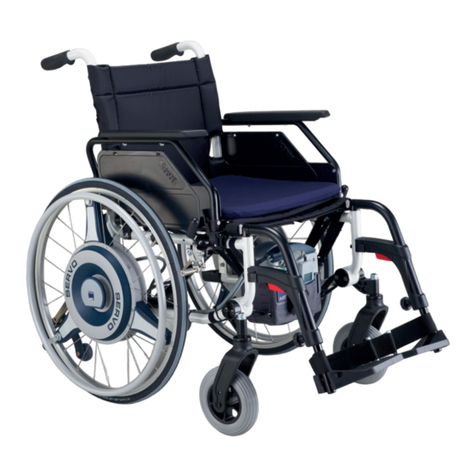
AAT
AAT SERVO BLACK EDITION R1602 Translation of the original user manual
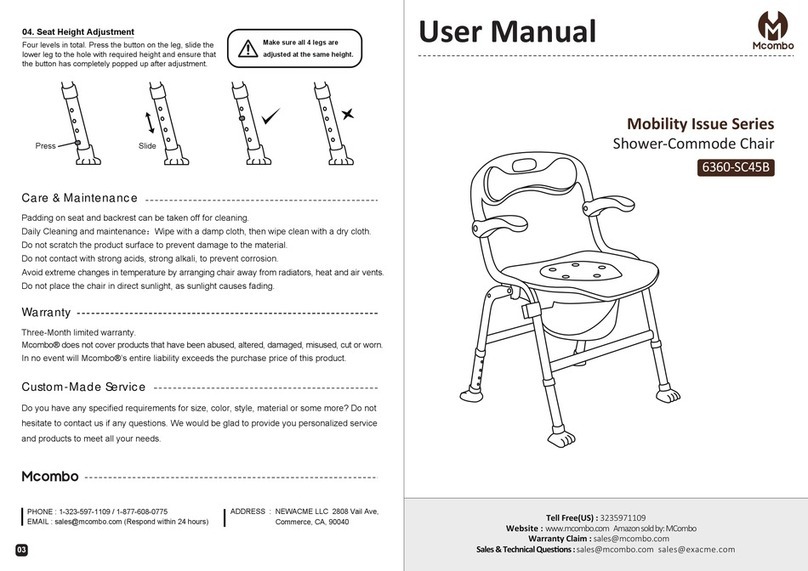
Mcombo
Mcombo Mobility Issue Series user manual

Tomtar
Tomtar BASIK Operating instructions manual
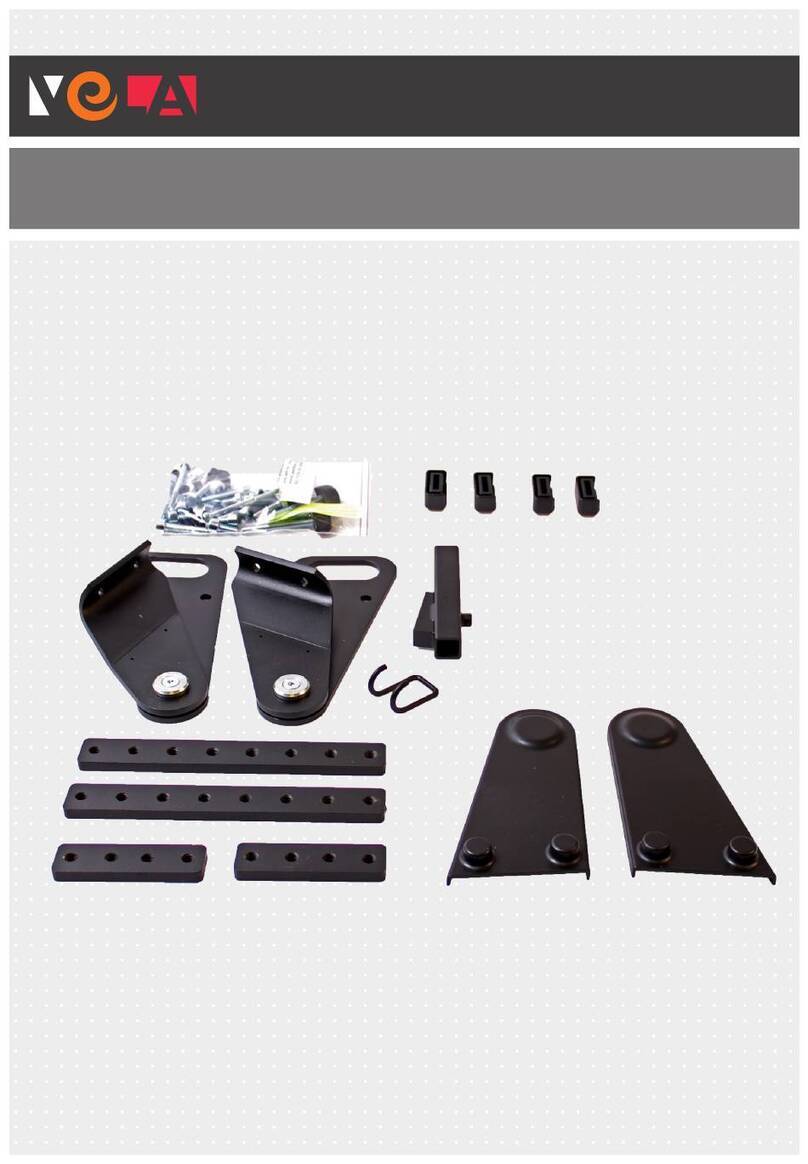
Vela
Vela Blues 100 Mounting instructions
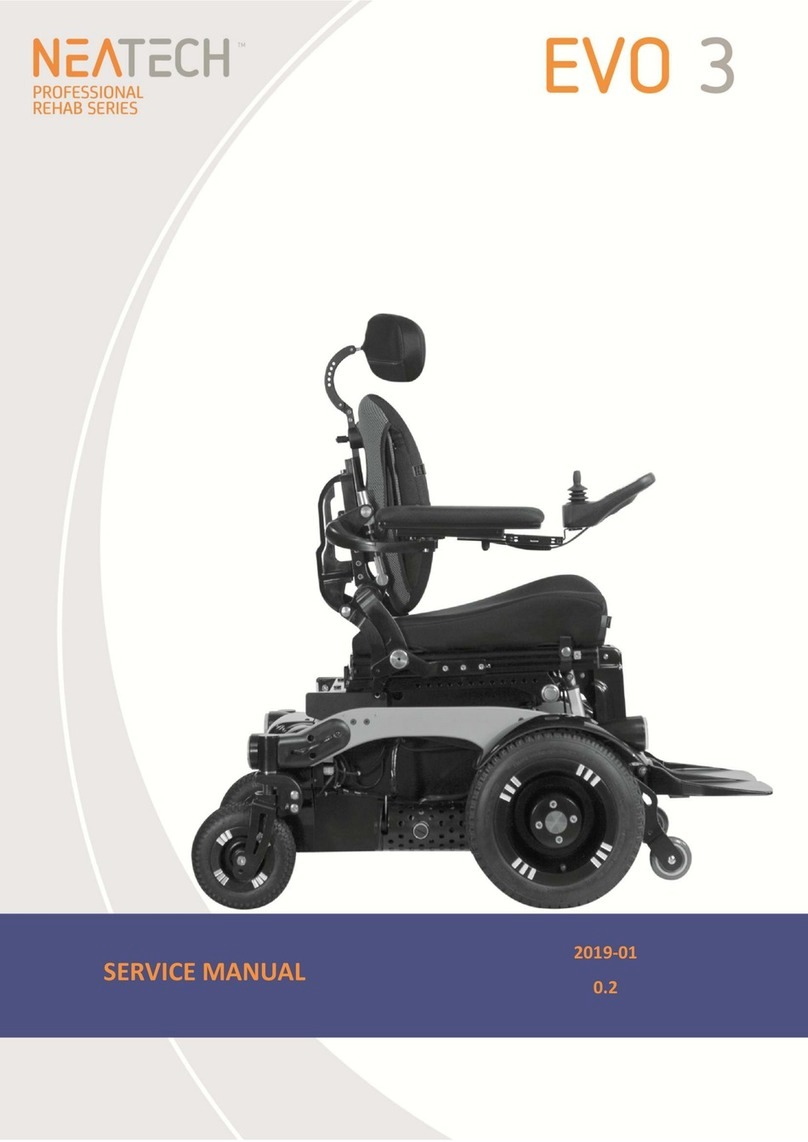
Neatech
Neatech PROFESSIONAL REHAB Series Service manual
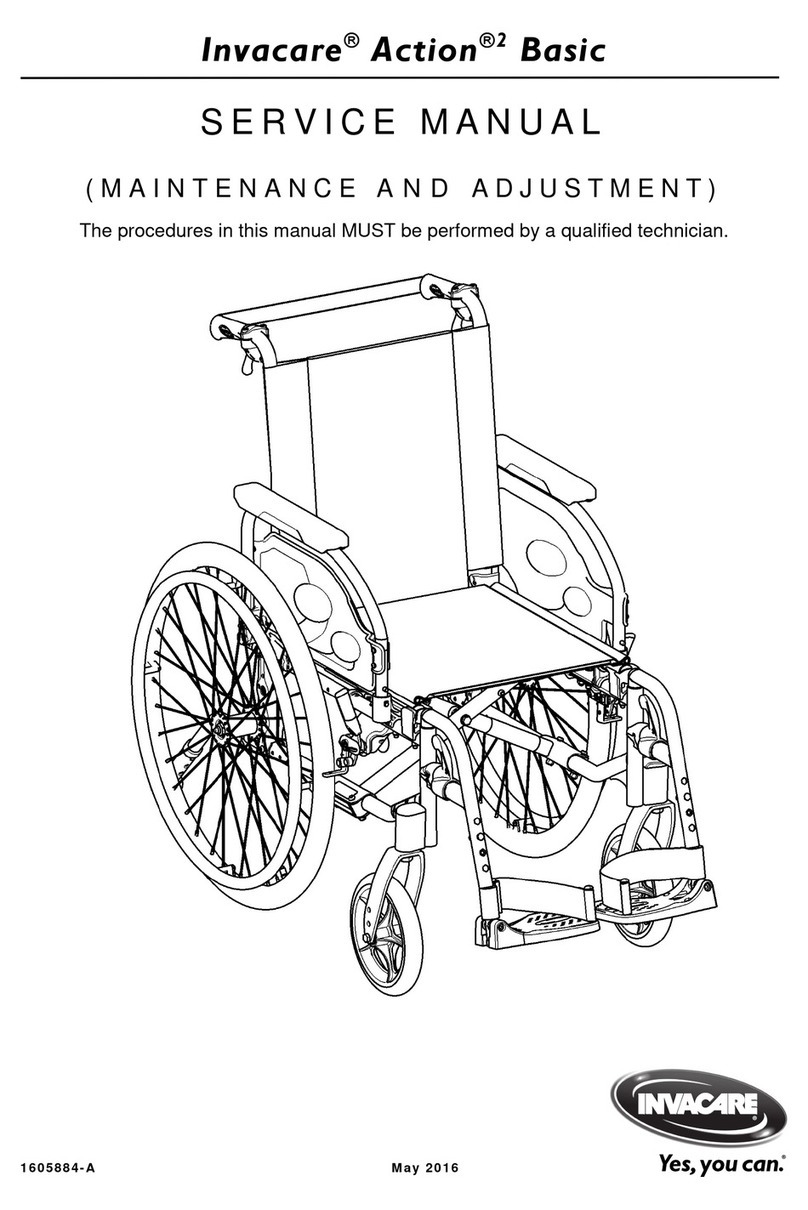
Invacare
Invacare Action 2 Basic Service manual

Travelux
Travelux Quest user manual

Decon wheel
Decon wheel MED3071 Assembly instructions

Invacare
Invacare Pronto M91 owner's manual

Golden Technologies
Golden Technologies Compass Sport GP605 Service guide

Invacare
Invacare XTERRA GT Operating and maintenance manual
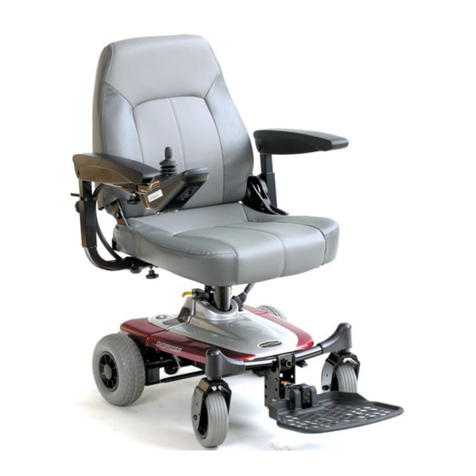
Shoprider
Shoprider SMARTIE UL8W owner's manual
